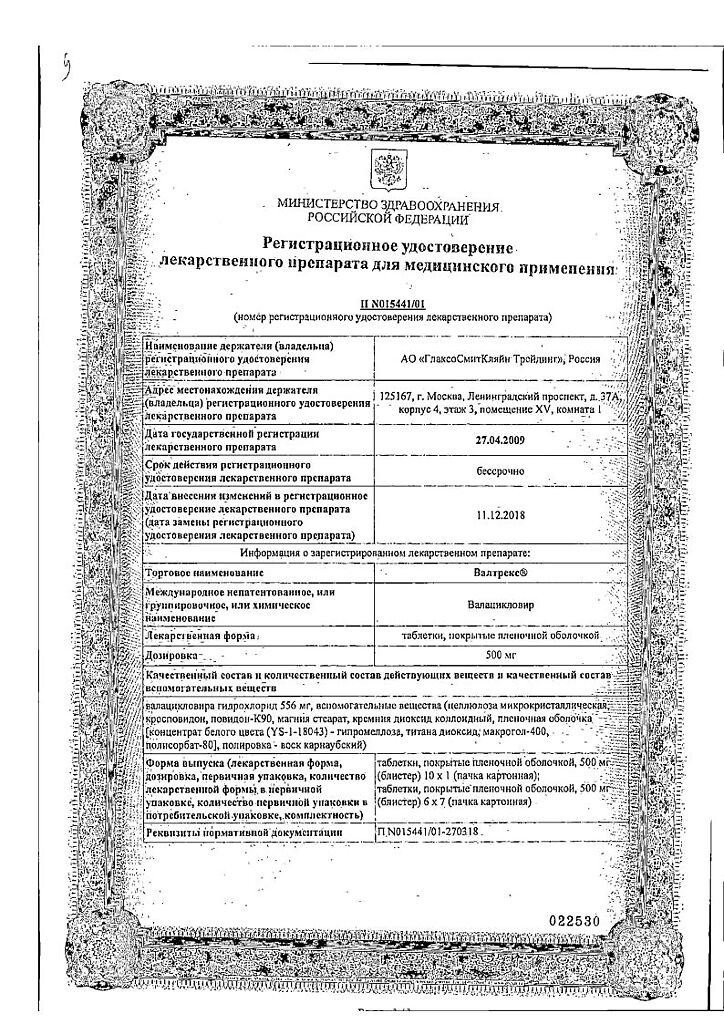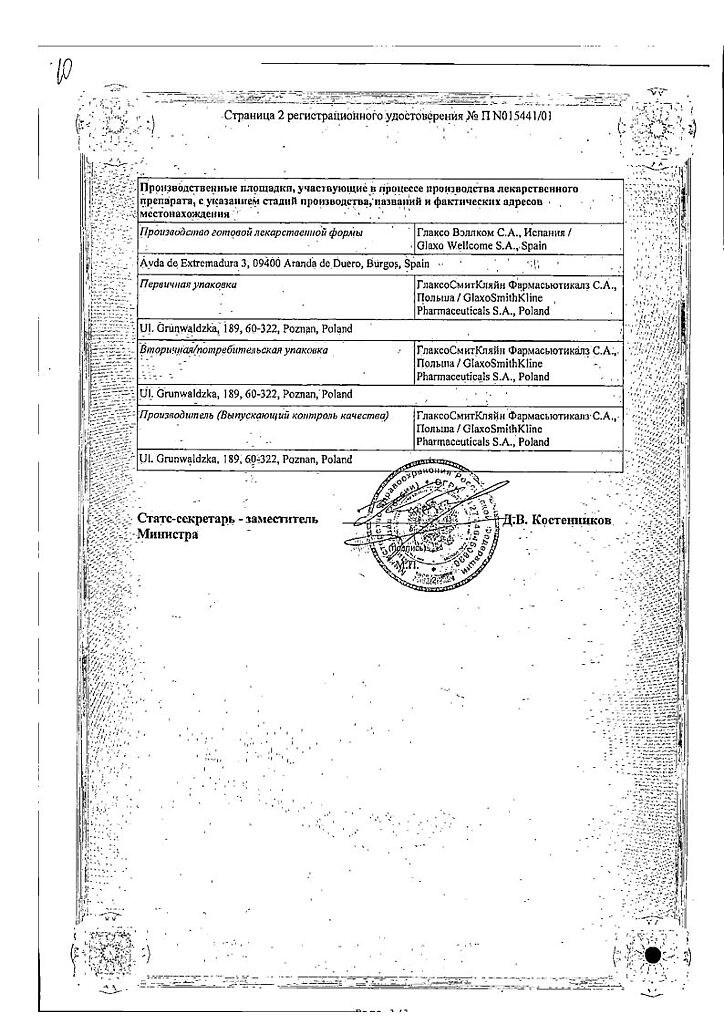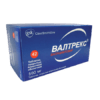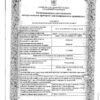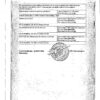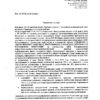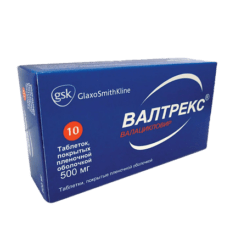No products in the cart.
Description
Pharmacodynamics
In human body valacyclovir is quickly and completely converted to acyclovir, under the influence of the enzyme valacyclovirhydrolase. Acyclovir has in vitro specific inhibitory activity against herpes simplex virus (HPV) types 1 and 2, varicella zoster virus (VZV), cytomegalovirus (CMV), Epstein-Barr virus (EBV) and human herpes virus type 6. Acyclovir inhibits the synthesis of viral DNA immediately after phosphorylation and transformation into the active form acyclovir triphosphate.
The first stage of phosphorylation requires activity of virus-specific enzymes. For HPV, VZV, and VEB, this enzyme is viral thymidine kinase, which is present in virus-affected cells. Partial phosphorylation selectivity is retained in cytomegalovirus and is mediated through the phosphotransferase gene product UL 97. Activation of acyclovir by a specific viral enzyme explains much of its selectivity.
The process of acyclovir phosphorylation (conversion from mono- to triphosphate) is completed by cellular kinases. Acyclovir triphosphate competitively inhibits viral DNA polymerase and, being a nucleoside analog, is incorporated into viral DNA, which leads to obligate breaking of the chain, cessation of DNA synthesis and, consequently, to blocking of virus replication.
In immunocompromised patients, HPV and VZV with decreased sensitivity to valacyclovir are extremely rare, but can sometimes be found in patients with severe immune impairment, such as those with bone marrow transplants, those receiving chemotherapy for malignancies and those infected with HIV.
Resistance is usually due to thymidine kinase deficiency, which leads to excessive spread of the virus in the host. Sometimes decreased sensitivity to acyclovir is due to the emergence of virus strains with disrupted viral thymidine kinase or DNA polymerase structure. The virulence of these varieties of the virus is similar to that of its wild strain.
Pharmacokinetics
General information: After oral administration valacyclovir is well absorbed from the gastrointestinal tract, quickly and almost completely converted to acyclovir and valine. This conversion is catalyzed by the enzyme valacyclovirhydralase isolated from human liver. After a single dose of valacyclovir of 250-2000 mg, the average peak plasma concentration of acyclovir in healthy volunteers with normal renal function is 10-37 µmol (2.2-8.3 µg/ml), and the median time to reach this concentration is 1-2 hours. The bioavailability of acyclovir is 54% when taking valacyclovir at a dose of 1,000 mg or more and is independent of food intake.
The peak plasma concentration of valacyclovir is only 4% of that of acyclovir, the median time of its achievement is 30-100 minutes after the dose, after 3 hours the peak concentration remains the same or decreases. Valacyclovir and acyclovir have similar pharmacokinetic parameters after oral administration.
The degree of binding of valacyclovir to plasma proteins is very low (only 15%). In patients with normal renal function, the half-life of acyclovir from plasma after valacyclovir administration is about 3 hours, and in patients with end-stage renal failure the average half-life is about 14 hours. Valacyclovir is excreted from the body with urine mainly as acyclovir (more than 80% of the dose) and acyclovir metabolite 9-carboxymethoxymethylguanine, less than 1% of the drug is eliminated in unchanged form.
Patient characteristics: Valacyclovir and acyclovir pharmacokinetics are not significantly impaired in patients infected with PH and VZ viruses.
In late pregnancy, the sustained daily area under the curve (area under the plasma concentration/time ratio curve ) after administration of 1000 mg of valacyclovir was approximately 2 times greater than that of acyclovir at a dose of 1200 mg per day. Valtrex administration at a dose of 1000 mg or 2000 mg does not impair the disposition and pharmacokinetic parameters of valacyclovir in HIV-infected patients compared to healthy individuals.
In organ transplant recipients receiving valacyclovir at a dose of 2000 mg 4 times daily, the peak acyclovir concentration is equal to or greater than that of healthy volunteers receiving the same dose of the drug, and their daily area under the curve is significantly higher.
Indications
Indications
Active ingredient
Active ingredient
Composition
Composition
Valacypovir hydrochloride 556 mg (equivalent to 500 mg of valacypovir).
Auxiliary substances:
Microcrystalline cellulose;
Crospovidone;
Povidone K 90;
Magnesium stearate;
White dye concentrate;
Carnauba wax;
Print ink;
Brilliant blue 5312 (FT 203).
How to take, the dosage
How to take, the dosage
Treatment of herpes zoster
Adults
Valtrex is given in a dose of 1000 mg 3 times daily for 7 days.
Treatment of infections caused by HPV Adults Valtrex is prescribed in a dose of 500 mg 2 times a day.
In cases of relapses, treatment should continue for 3 or 5 days. In more severe primary cases, treatment should be started as soon as possible, and its duration should be increased from 5 to 10 days. In relapsed HPV cases, it is ideal to prescribe Valtrex in the prodromal period or immediately after the onset of the first symptoms of the disease.
Alternatively for treatment of labial herpes (lip fever), Valtrex is effective when prescribed at a dose of 2 g twice for 1 day. The second dose should be taken approximately 12 hours (but not earlier than 6 hours) after the first dose. When using this dosing regimen, the duration of treatment should not exceed 1 day because it has been shown to provide no additional clinical benefit. Therapy should be initiated when the earliest symptoms of lip fever appear (i.e., tingling, itching, burning).
Prevention (suppression) of recurrent infections caused by HPV
Indications Clearance
creatinine,
ml/min . Dose
drug
Valtrex Creatine
creatine ./tr> Herpes zoster and ophthalmic
herpes zoster
in immunocompetent adults (treatment) 15-30 1 g once daily /td> less than 15 500 mg once daily 31-49 1 g 2 times a day
Patients with preserved immunity less than 15,250 mg once daily
-Patients with reduced immunity less than 15,500 mg once daily
Decreased infection with genital herpes less than 15,250 mg once daily
/p>
Patients on hemodialysis are recommended to use Valtrex immediately after completion of a hemodialysis session at the same dose as patients with a creatinine clearance less than 15 mL/min.
Prevention of CMV:
The regimen of Valtrex in patients with impaired renal function should be established as described below.
In patients on hemodialysis, Valtrex should be administered after completion of a hemodialysis session.
Creatinine clearance should be determined frequently, especially during periods when renal function changes rapidly, such as immediately after transplantation or graft engraftment, and the dose of Valtrex should be adjusted according to creatinine clearance rates.
Dose of Valtrex in impaired liver function
In patients with mild to moderate cirrhosis (synthetic liver function preserved) no dose adjustment of Valtrex is required. Pharmacokinetic data in patients with severe cirrhosis (with impaired hepatic synthetic function and the presence of shunts between the portal system and the common vascular system) also show no need to adjust Valtrex doses, however, experience in its clinical use in this pathology is limited.
Dosages in children
There are no data on the use of Valtrex in children.
Dosages in the elderlyt
Dose adjustment is not necessary except for significant impairment of renal function. Adequate water-electrolyte balance must be maintained.
Interaction
Interaction
Clinically significant interactions have not been established. Acyclovir is eliminated by the urine mainly unchanged, being actively secreted into the renal tubules. After prescribing 1g. Valtrex, cimetidine and probenecid, by blocking tubular secretion, increase the AUC of acyclovir and decrease its renal clearance.
However, this dose of Valtrex does not require any adjustment because of the broad therapeutic index of acyclovir. Caution should be exercised in the case of concomitant use of Valtrex at higher doses (4g per day) and drugs that compete with acyclovir for the elimination pathway, since there is a potential threat of elevated plasma levels of one or both drugs or their metabolites.
The AUC of acyclovir and the inactive metabolite of mycophenolate mofetil, an immunosuppressive drug used in transplantation, have been observed to increase when these drugs are used simultaneously.
Caution should also be exercised (watch for changes in renal function) when combining Valtrex at higher doses (4g per day or more) with drugs that affect other renal functions (e.g., cyclosporine, tacrolimus).
Special Instructions
Special Instructions
Hydration rate: In patients at risk of dehydration, especially in elderly patients, adequate fluid replenishment should be provided.
Application in renal failure: The dose of Valtrex should be adjusted according to the degree of renal impairment. Patients with renal insufficiency have an increased risk of developing neurological complications.
The use of higher doses of Valtrex in liver failure and liver transplantation: There are no data on the use of Valtrex at higher doses (4g or more per day) in patients with liver disease, so high doses of Valtrex should be prescribed with caution. No special studies have been conducted to investigate the effect of Valtrax in liver transplant patients. However, prophylactic administration of aceclavir at high doses has been shown to reduce CMV infection.
Application in genital herpes: Suppressive therapy with Valtrex reduces the risk of transmission of genital herpes, but does not completely eliminate it and does not lead to a complete cure. Valtrex therapy is recommended in combination with safe sex.
Impact on ability to drive and operate machinery
No special precautions are required.
Contraindications
Contraindications
Valtrex is contraindicated in patients with hypersensitivity to valacyclovir, acyclovir, or any of the excipients in Valtrex.
We should use with caution in clinically significant forms of HIV infection.
Side effects
Side effects
Unwanted reactions are listed below according to classification by major systems and organs and by frequency of occurrence.
Frequency measures used:
Very common: ⥠1 in 10
Frequent: ⥠1 in 100 or < 1 in 10;
Infrequent: ⥠1 in 1000 or < 1 in 100
Rare: ⥠1 in 10000 or < 1 in 1000
Very rare: < 1 in 10000.
Nervous system disorders
Often: headache.
Gastrointestinal tract disorders
Often: nausea.
Post-marketing study data
Blood and lymphatic system disorders
Very rare: leukopenia, thrombocytopenia. Mostly leukopenia was noted in patients with reduced immunity.
Disorders of the immune system
Very rare: anaphylaxis.
Psychiatric and nervous system disorders
Rare: dizziness, confusion, hallucinations, decreased mental capacity.
Very rare: agitation, tremor, ataxia, dysarthria, psychotic symptoms, seizures, encephalopathy, coma.
The above symptoms are reversible and are usually seen in patients with impaired renal function or with other predisposing conditions. Transplant patients receiving high doses (8 g per day) of Valtrex to prevent CMV infection are more likely to develop neurological reactions than those receiving lower doses.
Respiratory, thoracic and mediastinal disorders
Infrequent: dyspnea
Gastrointestinal disorders
Rarely: Abdominal discomfort, vomiting, diarrhea
Liver and biliary tract disorders
Very rare: reversible abnormalities of functional liver tests, which are sometimes considered as manifestations of hepatitis.
Skin and subcutaneous tissue disorders
Infrequent: rash, including photosensitivity.
Rare: itching.
Very rare: urticaria, angioedema.
Renal and urinary tract disorders
Rare: renal dysfunction. Very rare: acute renal failure, renal colic. (Renal colic may be associated with impaired renal function.).
Others: Cases of renal failure, microangiopathic hemolytic anemia and thrombocytopenia (sometimes in combination) have been observed in patients with severe immune disorders, especially in patients with advanced AIDS, receiving high doses of valacyclovir (8 g daily) for a long period of time. Similar complications have been noted in patients with the same disease but not receiving valacyclovir.
Overdose
Overdose
Symptoms and signs:
Data on Valtrex overdose are insufficient. A single overdose of acyclovir up to 20 g, which was partially absorbed from the gastrointestinal tract, was not accompanied by toxic effects of the drug. Oral administration of ultra-high doses of acyclovir over several days was associated with gastrointestinal (nausea and vomiting) and neurological symptoms (headache and confusion).
Overdoses with intravenous administration of acyclovir are accompanied by elevated serum creatinine levels and subsequent development of renal failure, with neurological complications including confusion, hallucinations, agitation, seizures and coma.
Management:
Patients should be closely monitored for signs of toxic effects. Hemodialysis significantly enhances the removal of acyclovir from the blood and may be considered the method of choice in the management of patients with Valtrex overdose.
Pregnancy use
Pregnancy use
Teratogenicity: Valacyclovir has no teratogenic effect in rats and rabbits. Valacyclovir is almost completely metabolized to form acyclovir. Subcutaneous administration of acyclovir in conventional teratogenicity tests did not cause teratogenic effects in rats and rabbits. In additional studies on rats, abnormalities in fetal development were found when the drug was administered subcutaneously in doses that increased the plasma concentration of acyclovir to 100 mcg/mL and caused toxic effects in the mother.
Fertility: when administered orally, valacyclovir caused no impairment of fertility in male and female rats.
Pregnancy:There are insufficient data on the use of Valtrex in pregnancy. Valtrex should be used in pregnancy only if the potential benefit exceeds the potential risk. Pregnancy outcome data from registries of women taking Valtrex or Zovirax (acyclovir is the active metabolite of valacyclovir) showed no increase in birth defects in their children compared to the general population. Because the registry included a small number of women who took valacyclovir during pregnancy, no reliable and definitive conclusions about the safety of valacyclovir in pregnancy can be drawn.
Lactation: acyclovir, the main metabolite of valacyclovir, is excreted in breast milk. After oral administration of valacyclovir at a dose of 500 mg, the maximum concentration of acyclovir (Cmax) in breast milk was 0.5-2.3 times (1.4 times on average) higher than the corresponding concentrations of acyclovir in maternal plasma. The ratio of the AUC of acyclovir in breast milk to the AUC of acyclovir in maternal plasma ranged from 1.4 to 2.6 (mean value 2.2).
The mean concentration of acyclovir in breast milk was 2.24 µg/mL (9.95 µgM). If the mother takes valacyclovir at a dose of 500 mg twice daily, the baby will have the same exposure to acyclovir as if she were taking it orally at a dose of about 0.61 mg/kg/day. The half-life of acyclovir from breast milk is the same as that of blood plasma. Valacyclovir was not detected unchanged in maternal plasma, breast milk, or infant urine.
Valtrex should be administered with caution to breastfeeding women. However, intravenous administration of Zovirax at a dose of 30 mg/kg/day is used in infants to treat diseases caused by herpes simplex virus.
Similarities
Similarities
Additional information
| Weight | 0.058 kg |
|---|---|
| Shelf life | 3 years |
| Conditions of storage | At a temperature not exceeding 30 °C |
| Manufacturer | GlaxoSmithKline Pharmaceuticals S.A., Poland |
| Medication form | pills |
| Brand | GlaxoSmithKline Pharmaceuticals S.A. |
Other forms…
Related products
Buy Valtrex, 500 mg 42 pcs with delivery to USA, UK, Europe and over 120 other countries.


